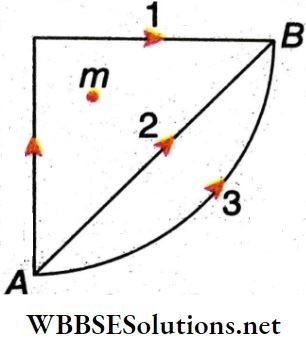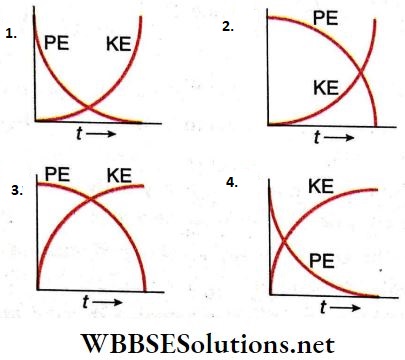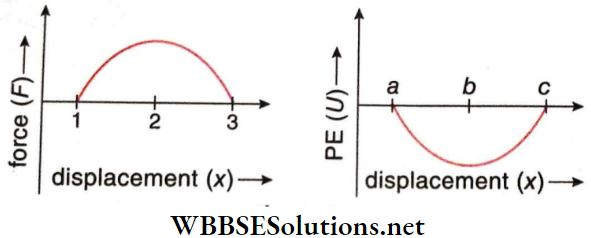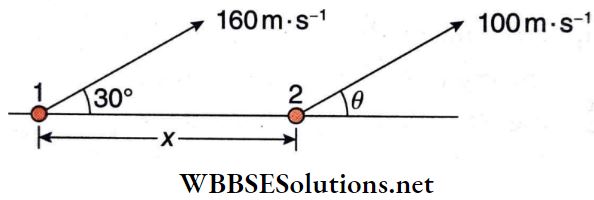Work And Energy Multiple Choice Questions And Answers
Question 1. A constant force \(\vec{F}=-\hat{i}+2 \hat{j}+3 \hat{k} \mathrm{~N}\) acts on a body, and shifts it 4 m along the z-axis and then 3 m along the y-axis. Work done by \(\vec{F}\) will be
- 6J
- 12 J
- 18 J
- 24 J
Answer: 3. 18 J
Question 2. A force acts on a particle of mass 3 kg, such that the position of the particle changes with time as per the equation x = 3t – 4t² + t3 if we express x in m and t in s, work done in 4 s will be
- 570 mJ
- 450 mJ
- 490 mJ
- 576 mJ
Answer: 4. 576 mJ
Question 3. A chain is on a smooth horizontal table with 1/3 of its length hanging off the edge. If the mass and length of the chain are M and l respectively, work done to pull up the hanging part of the chain will be [g = acceleration due to gravity]
- Mgl
- \(\frac{M g l}{3}\)
- \(\frac{M g l}{9}\)
- \(\frac{M g l}{18}\)
Answer: 4. \(\frac{M g l}{18}\)
Question 4. As an object revolves in a circular path of radius r, a force F is acting on it such that its direction is perpendicular to that of the instantaneous velocity v of the object. Work done by the force in one complete revolution is
- F · v
- F · r
- F · 2πr
- 0
Answer: 4. 0
Question 5. A particle moving on xy -plane is acted upon by a force \(\vec{F}=-K(y \hat{i}+x \hat{j})\), where AT is a constant. Starting from the origin, the particle is brought to the point (a, 0) along the positive x-axis and then to the point (a, a) parallel to the y-axis. Work done by the force on the particle will be
- -2Ka²
- 2 Ka²
- -Ka²
- Ka²
Answer: 3. -Ka²

Question 6. A force is acting on a mass of 6 kg. Displacement x of the mass is related to time t as x = \(\frac{t^2}{4}\) m. Work done by the force in 2 s is
- 12 J
- 9J
- 6 J
- 3 J
Answer: 4. 3 J
Question 7. Work done by a force \(\vec{F}=(\hat{i}+2 \hat{j}+3 \hat{k}) \mathrm{N}\) acting on a particle in displacing it from the point \(\overrightarrow{r_2}=\hat{i}-\hat{j}+2 \hat{k}\) to the point \(\vec{r}_1=\hat{i}+\hat{j}+\hat{k}\) is
- -3 J
- -1J
- Zero
- 2J
Answer: 2. -1J
Question 8. A particle could be taken from point A to point B following three paths, 1,2, and 3, as shown Work done in these three cases are W1, W2, and W3 respectively. If these works are done in the gravitational field of a point mass m, W1, W2, W3 are related as

- W1 > W3> W2
- W1 = W2 = W3
- W1 < W3 <W2
- W1 < W2 < W3
Answer: 2. W1 = W2 = W3
Question 9. A mass M is lowered with the help of a string by a distance x at a constant acceleration The magnitude of work done by the string will be
- Mgx
- 1/2 Mgx²
- 1/2 Mgx
- Mgx²
Answer: 3. 1/2 Mgx
Question 10. Force acting on a particle is (\(2\hat{i}+3 \hat{j}\))N. Work done by this force is zero when a particle is moved on the line 3y+ kx = 5. Here value it is
- 2
- 4
- 6
- 8
Answer: 1. 2
Question 11. A particle of mass m accelerating uniformly has velocity v at time t1. What is work done in time t?
- \(\frac{1}{2} \frac{m v^2}{t_1^2} t^2\)
- \(\frac{m v^2}{t_1^2} t^2\)
- \(\frac{1}{2}\left(\frac{m}{t_1}\right)^2 t^2\)
- \(\frac{2 m v^2}{t_1^2} t^2\)
Answer: 1. \(\frac{1}{2} \frac{m v^2}{t_1^2} t^2\)
Question 12. A mass of 2 kg falls from a height of 40 cm on a spring with a force constant of 1960 N/m. The spring is compressed by (take g = 9.8 m/s²)
- 10 cm
- 1.0 cm
- 20 cm
- 5 cm
Answer: 1. 10 cm
Question 13. A gardener pushes a lawn roller through a distance 20 m. If he applies a force of 20 kg-wt in a direction inclined at 60° to the ground, the work done by him is
- 1960 J
- 196 J
- 1.96 J
- 196 KJ
Answer: 1. 1960 J
Question 14. The power required to raise a mass of 120 kg vertically upwards at a velocity of 4.5 m · s-1 is
- 5kW
- 5.3 kW
- 8 kW
- 11.2 kW
Answer: 2. 5.3 kW
Question 15. A machine, applying a constant power, is driving an object along a straight line. Displacement of the object in time t is
- Directly proportional to √t
- Directly proportional to \(\sqrt[4]{t^3}\)
- Directly proportional to \(\sqrt{t^3}\)
- Directly proportional to t²
Answer: 3. Directly proportional to \(\sqrt{t^3}\)
Question 16. A windmill generates electrical energy. Suppose, the windmill converts a fixed part of the wind energy linked with the blades, to electrical energy. If the wind velocity is v, the output electric power is directly proportional to
- v
- v²
- v3
- v4
Answer: 3. v3
Question 17. A particle moves with a velocity \(5 \hat{i}-3 \hat{j}+6 \hat{k}\) m/s under the influence of a constant force, \(\vec{F}=10 \hat{i}+20 \hat{k} \mathrm{~N}\). The instantaneous power applied to the particle is
- 200 J/s
- 40J/S
- 140 J/s
- 170 J/s
Answer: 4. 170 J/s
Question 18. A quarter-horsepower motor runs at a speed of 600 rpm. Assuming 40% efficiency, the work done by the motor in one rotation will be
- 7.46 J
- 7400 J
- 7.46 erg
- 74.6 J
Answer: 1. 7.46 J
Question 19. The energy of a body thrown upward is
- Maximum at the highest point
- Minimum at the highest point
- Same at all points
- Can be maximum at any point
Answer: 3. Same at all points
Question 20. A particle is moving in a straight line such that its retardation is directly proportional to its displacement. A decrease in the kinetic energy of the body is directly proportional to
- x²
- ex
- x
- logex
Answer: 1. x²
Question 21. Starting from rest a car moves on a plane. The coefficient of friction (μ) between the tyres and the plane increases linearly with the distance (x). The kinetic energy (K) of the car depends on x as
- \(K \propto \frac{1}{x^2}\)
- \(K \propto \frac{1}{x}\)
- \(K \propto x\)
- \(K \propto x^2\)
Answer: 4. \(K \propto x^2\)
Question 22. A particle falls from rest under the action of gravity. Variation of kinetic energy (KE) and potential energy (PE) of the particle, with time t is represented by the graph

Answer: 2
Question 23. A long spring is stretched by 2 cm. Its potential energy is U. If the spring is stretched by 10 cm, its potential energy would be
- \(\frac{U}{25}\)
- \(\frac{U}{25}\)
- 5 U
- 25 U
Answer: 4. 25 U
Question 24. In which of the following cases the potential energy is defined
- Both conservative and non-conservative forces
- Conservative force only
- Non-conservative force only
- Neither conservative nor non-conservative forces
Answer:
Question 25. A body of mass m thrown vertically upwards attains a maximum height h. At what height will its kinetic energy be 75% of its initial value?
- \(\frac{h}{6}\)
- \(\frac{h}{5}\)
- \(\frac{h}{4}\)
- \(\frac{h}{3}\)
Answer: 3. \(\frac{h}{4}\)
Question 26. For a moving particle (mass m, velocity v) having a momentum p, which one of the followings correctly describes the kinetic energy of the particle?
- \(\frac{p^2}{2 m}\)
- \(\frac{p}{2 m}\)
- \(\frac{v^2}{2 m}\)
- \(\frac{v}{2 m}\)
Answer: 1. \(\frac{p^2}{2 m}\)
Question 27. The potential energy of a system increase if work is done
- By the system against a conservative force
- By the system against a non-conservative force
- Upon the system by a conservative force
- Upon the system by a non-conservative force
Answer: 1. By the system against a conservative force
Question 28. Two bodies of masses 4 kg and 5 kg are moving with equal momentum. Then, the ratio of their respective kinetic energies is
- 4:5
- 2:1
- 1:3
- 5:4
Answer: 4. 5:4
Question 29. A particle of mass m at rest is acted upon by a force P for a time t. Its kinetic energy after an interval t is
- \(\frac{p^2 t^2}{m}\)
- \(\frac{p^2 t^2}{2 m}\)
- \(\frac{p^2 t^2}{3 m}\)
- \(\frac{P t}{2 m}\)
Answer: 2. \(\frac{p^2 t^2}{2 m}\)
Question 30. If the linear momentum of a body is increased by 50%, then the kinetic energy of that body increases by
- 100%
- 125%
- 225%
- 25%
Answer: 2. 125%
Question 31. One end of a thread of length h has a stone tied to it. Taking the other end as the center, it revolves in a vertical plane. When the stone reaches the lowest point of its path, it attains the speed u. When the thread is horizontal, the speed of the stone is
- \(\sqrt{u^2-2 g h}\)
- \(\sqrt{u^2-g h}\)
- \(\sqrt{2 g h}\)
- \(2 \sqrt{u^2-g h}\)
Answer: 1. \(\sqrt{u^2-2 g h}\)
Question 32. Along the surface of a hemispherical container, a small ball is pushed down from a height of h, such that the ball rises up to the opposite edge. If the height of the container is R, the ball must be pushed with a velocity
- √2gh
- √2gR
- √2g(R+h)
- √2g(R-h)
Answer: 4. √2g(R-h)
Question 33. A bucket full of water is rotated in a vertical circle of radius r. If the water does not split out, the minimum speed of the bucket at top most point will be
- √rg
- √5rg
- √2rg
- √r/g
Answer: 1. √rg
Question 34. A ball with a momentum p falls on a floor vertically and bounces a number of times. If the coefficient of restitution is e, momentum transferred to the floor is
- p(1 + e)
- \(\frac{p}{1-e}\)
- \(p\left(1+\frac{1}{e}\right)\)
- \(\left(p\left(\frac{1+e}{1-e}\right)\right.\)
Answer: 4. \(\left(p\left(\frac{1+e}{1-e}\right)\right.\)
In this type of question, more than one option are correct.
Question 35. The potential energy of a particle is given by the formula U = 100 – 5x+ 100x², U and x are in SI units. If the mass of the particle is 0.1 kg then the magnitude of its acceleration
- At 0.05 m from the origin is 50 m · s-2
- At 0.5 m from the mean position is 100 m· s-2
- At 0.05 m from the origin is 150 m · s-2
- At 0.05 m from the mean position is 200 m · s-2
Answer:
Question 36. With reference to the graphs, which of the following are correct?

- The particle has stable equilibrium at points 3 and b
- The article is in neutral equilibrium at points b and 2
- No power is delivered by the force on the particle at points 1, 3, and b
- The particle has the least kinetic energy at position 1
Answer:
1. The particle has stable equilibrium at points 3 and b
3. No power is delivered by the force on the particle at points 1, 3, and b
4. The particle has the least kinetic energy at position 1
Question 37. When a bullet is fired from a gun
- The kinetic energy of a bullet is more than that of a gun
- The acceleration of a bullet is more than that of a gun
- The momentum of the bullet is more than that of the gun
- The velocity of a bullet is more than that of gun
Answer:
1. The kinetic energy of a bullet is more than that of gun
2. The acceleration of the bullet is more than that of gun
4. The velocity of the bullet is more than that of the gun
Question 38. Suppose two particles 1 and 2 are projected in the vertical plane simultaneously. Their angles of projection are 30° and θ, respectively with the horizontal. Suppose they collide after a time t in the air. Then

- \(\theta=\sin ^{-1}\left(\frac{4}{5}\right)\) and they will have same speed just before the collision
- \(\theta=\sin ^{-1}\left(\frac{4}{5}\right)\) and they will have different speeds just before the collision
- x < (1280√3 – 960)m
- It is possible that the particles collide when both of them are at their highest points
Answer:
2. \(\theta=\sin ^{-1}\left(\frac{4}{5}\right)\) and they will have different speeds just before the collision
3. \(\theta=\sin ^{-1}\left(\frac{4}{5}\right)\) and they will have different speeds just before the collision
4. It is possible that the particles collide when both of them are at their highest points

